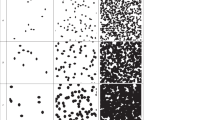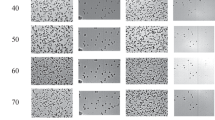Abstract
Solid-state track detectors made of glass have been used for detecting fission fragments since the 1960s [1–3]. These detectors are efficient for recording, they are relatively insensitive to light and background beta and gamma radiations, and they have a low own background. The passage of a multicharged ion in a glass creates a hidden image in the form of residual defects along the track of the ion with a width of ~10 nm. This hidden image can be detected by chemical etching. In an optical microscope, the etched track is observed as a well of a conical shape with a vertex coinciding with the trajectory of the particle, and with a diameter on the glass surface of the order of 5 to 10 μm. Compared to other solid-state detectors of multicharged ions (micas, plastics), glasses have a number of advantages, especially the lack of layering, which prevents the restoration of the full length of the track. We need to note the spectrometric property of glasses, namely, the proportionality of the linear size of the etched defect to the charge of the particle slowing in the detector to a stop. This property allows establishing a relationship between the particle charge and the geometric parameters of the track. In this study we used phosphate glasses as materials for detectors of charged particles. In these glasses, the main glass-forming component is phosphorus pentoxide P2O5. In particular, phosphates were successfully used in 1969 at the LNR JINR in an experiment to search for element 105 by spontaneous fission [4]. Previously we demonstrated a successful implementation of the automated processing of the detected tracks [5]. The aim of this study is to develop an offline method for an automated search for rare events of the decay of superheavy nuclei in order to record multicharged ions and determine their characteristics.









Similar content being viewed by others
REFERENCES
V. A. Nikolaev, Solid-State Track Detectors in Radiation Research (SPb. Politekh. Univ., St. Petersburg, 2012) [in Russian].
V. A. Nikolaev and V. P. Perelygin, Prib. Tekh. Eksp. 19 (2), 7 (1976).
S. P. Tret’yakova, Sov. J. Part. Nucl. 23, 156 (1992).
G. N. Flerov et al., Sov. At. Energy 28, 390 (1970). https://doi.org/10.1007/BF01428736
A. B. Aleksandrov et al., Nucl. Instrum. Methods Phys. Res., Sect. A 535, 542 (2004). https://doi.org/10.1016/j.nima.2004.07.280
L. A. Goncharova et al., PhIAS Preprint No. 25 (Lebedev Phys. Inst. Acad. Sci., Moscow, 2001).
Author information
Authors and Affiliations
Corresponding author
Ethics declarations
The authors declare that they have no conflicts of interest.
Additional information
Translated by V. A. Alekseev
Rights and permissions
About this article
Cite this article
Goncharova, L.A., Konovalova, N.S., Okateva, N.M. et al. Method of an Automated Search for Rare Events of Superheavy Nuclei Decay Using Phosphate Glass Detectors. Phys. Atom. Nuclei 83, 1304–1312 (2020). https://doi.org/10.1134/S1063778820090112
Received:
Revised:
Accepted:
Published:
Issue Date:
DOI: https://doi.org/10.1134/S1063778820090112




